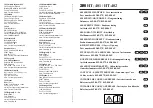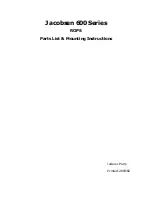
158
Detailed description of the inspection and maintenance work
[1]
Wipe off using a soft cloth (and some water with a normal household detergent).
[2]
Leaking connections can be identified by moisture or crystals at the threaded connections of the hoses,
at the sealing lips of the piston inside the dosing cylinder or at the valve.
[3]
If any liquid becomes visible below the first sealing lip, it has to be checked at short timely intervals
whether any liquid will build up under the second sealing lip, too. In this case both the piston and the
glass cylinder have to be replaced immediately. It is easily possible that in operation small liquid droplets
build up under the first sealing lip, but they may also disappear again. This phenomenon alone is no
reason for replacement.
[4]
The valve has to be removed from its housing for inspection. In this process, the hoses remain
connected to the valve. Please check for moisture underneath the valve. When reinserting the valve,
please make sure that the small cam at the rotating axis is fitted into the corresponding groove again.
[5]
The titration tip must be free of sedimentation or crystals which might obstruct the dosing process or
falsify the results.
[6]
Remove the cylinder, take the valve out of the valve housing, unscrew the hoses and then rinse all parts
carefully with distilled water. For the assembly of the cylinder, hoses and other parts of the
interchangeable unit, please refer to the operating instructions.
[7]
Dose one burette volume, then refill. Air bubbles will gather at the tip of the cylinder and in the titration
hose where they can be detected easily. If bubbles become visible, please re-tighten all connections
finger tight, and then repeat dosing. If air bubbles still remain within the system, [6] please check the
valve and replace the hose connections. The air bubbles may also occur at the interface between the
sealing lip of the piston and the cylinder. If a reduction of the filling speed will not do, the dosing unit has
to be replaced.
[8]
Check the electrical plug contacts for corrosion and mechanical damage. Defective parts have to be
repaired or replaced by new parts.
[9]
Please refer to the application
“
Buret
te inspection according to ISO 8655 Part 6”.
9
Guarantee
We provide guarantee for the device described for two years from the date of purchase. This
guarantee covers manufacturing faults being discovered within the mentioned period of two years.
Claim under guarantee covers only the restoration of functionality, not any further claim for damages
or financial loss. Improper handling/use or illegitimate opening of the device results in loss of the
guarantee rights. The guarantee does not cover wear parts, as lobes, cylinders, valves and pipes
including the thread connections and the titration tips. The breach of glass parts is also excluded.
To ascertain the guarantee liability, please return the instrument and proof of purchase together with
the date of purchase freight paid or prepaid.
10
Storage and transportation
If the TitroLine
®
5000 or the interchangeable units have to be stored over some time, or to be
dislocated, the use of the original packing will be the best protection of the devices. However, in many
cases this packing will not be available anymore, so that one will have to compose an equivalent
packaging system. Sealing the lower section in a foil is hereby recommended. The devices should be
stored in a room with a temperature between + 10 and + 40 °C, and the (relative) humidity of the air
should not exceed 70 %.
If the interchangeable have to be stored over some time, or to be dislocated, the fluids inside the
system, especially aggressive solution have to be removed.
11
Recycling and Disposal
Please observe the applicable local or national regulations concerning
the disposal of “waste
elect
rical and electronic equipment”.
The TitroLine
®
5000 and his packaging are manufactured as far as possible from materials which can
be disposed of environmental-friendly and recycled in a technically appropriate manner. If you have
any question regarding disposal, please contact the service (see backside of this manual).
The main printed board carries a lithium battery (type CR 2430). Batteries should not to be
disposed of with the normal domestic waste. They will be taken back and recycled or disposed of
properly by the manufacturer at no cost.





































